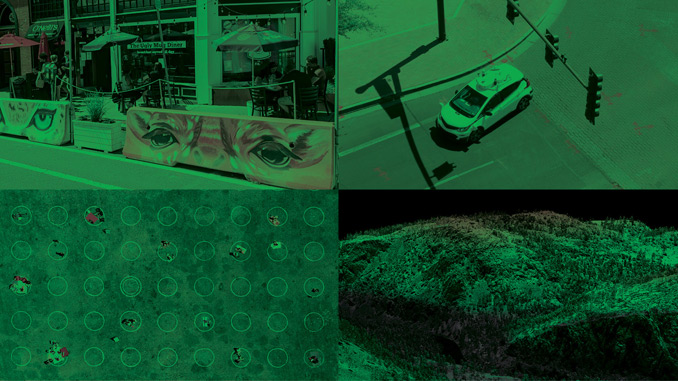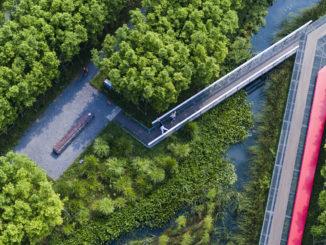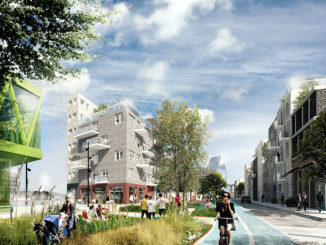
One year ago, I published my predictions for 2020 landscape architecture trends with little understanding of how 2020 would be quite different from what we were expecting. With COVID shutting down many cities and design firms working from home, it forever changed the landscape architecture profession. It accelerated the adoption of various platforms such as Zoom, Teams, Slack and many others. It also highlighted the amount of travel (often unnecessary) we undertake to meet with clients, undertake construction inspections and more. Teaching, Events, Conferences, and Awards all moved online, which reduced many events’ carbon footprint. However, many may go back to physical events in 2021 due to the social aspect and maintain revenues, thus sustaining their organisations (universities, associations, etc.)
Interestingly some of the trends that I predicted in 2020 have been accelerated, including Suburban town centres, Complete Streets, Change in Practice.
The following is my predictions for 2021 landscape architecture trends.
Climate Change
The world’s greatest issue will continue to change the way we design, but it will have a greater focus on health as the cost of air pollution on people, livestock, and crops are felt with increasing impact in the 2020s. The implications for waterfront cities’ will become more apparent with many cities seeking solutions to rising tides such as Venice’s flood barriers that were activated during 2020.
Weather patterns and change in climatic zones will impact the profession. We will have to address extreme weather events, including flooding, droughts, and the long-term implications that will require us to incorporate environmental changes such as species adaptation food security, and more issues we will face.
Impact of COVID on design
2021 will see some changes in the way we design spaces, as we saw the changes in security standards after the 2016-2018 vehicle attacks, we will see some countries and cities implement design standards. However, the changes will be dependent on the rollout of the vaccine and mitigation of the ongoing waves.
Emphasis on outdoor space
As we see people seek to relax and rediscover the outdoors after lockdowns, residents will push cities to increase the quality and maintenance of public spaces. We are already seeing the impact of increased open space usage with overflowing bins and stacked rubbish within parks after weekends.
Rediscovering Gardens
More people are rediscovering their gardens and seeking out designers to improve their residential garden with play spaces, entertaining patios and vegetable gardens. Based on the increased sales at nurseries and hardware (home improvement) stores during 2020, we can expect that landscape architects will see an increase (or recovery) in residential work.
Temporary Spaces
The recent trend of open-air pop-up markets, street dining, parklets will increase in 2021 as we see cities try to drawback people from the suburbs into the central activity/business districts of cities and towns.
Regional growth
Many people and companies have realised that work from home and work from anywhere is possible. We will see many companies allow people to remote work. Therefore families will seek out sea changes, tree changes, and move to regional cities and towns away from major centres as they seek a better work-life balance. Therefore, there will be increased projects and work for landscape architects as regional towns seek to attract these new residents to their city or town. It will also mean a dip in the population for some major centres.
Suburban Town Centres
Following on from regional growth, we will see changes and revitalisation of suburban centres and shopping (main/high) streets as people avoid going into the city core. They will seek out their local coffee shop, grocer, and increase their online shopping for appliances, clothes, etc. Landscape architects will need to reimagine these streets (and grids) into more pedestrian-friendly zones.
The shift to online shopping and open-air main streets may accelerate the closing of shopping malls/centres. Many savvy developers will repurpose these failing malls into town centres with office space, hotels, food streets, markets, dining-lifestyle precincts and move away from pure retail-focused spaces (the mix of indoor and outdoor will be dependent on the local climate). Hopefully, we will see this increase the number of projects for landscape architects as developers seek to create more mini-town centres by repurposing retail malls. This trend has been growing for the past decade but may accelerate and create a greater diversity of landscape typologies.
Over the past decade, governments have embraced the 15 (20) minute city by creating policies to encourage government departments and developers to change the way they design and develop areas. This change in growth patterns (decentralising to suburban town centres) caused by a shift in policy and accelerated by COVID-19 may be the catalyst that pushes many encouraged developers and government departments to change their business and funding models to create walkable, connected town centres.
These trends may increase the number of public-private partnerships, as many cities won’t have the budgets to facilitate these new typologies and reconfiguration of main streets and towns centres.
Transport
As cities seek to address climate change and improve the quality of life, we will change the way we move around cities. Many different ideas will be tested, including pedestrianising city centres, park and ride, shared mobility, congestion zones, zero-emission zones, autonomous vehicles, logistic zones, and many more initiatives. The profession will need to be open to collaborating with transport engineers, cities and technologists to create livable towns and streets that accommodate these mobility changes.
Technology – Implementation
Implementing technological networks and systems across cities is inevitable as governments embrace Smart Cities from smart parking, bins, maintenance, service logistics, and more. It will also accelerate as the costs of networks and sensors decrease, and bandwidth speeds increase with the role out of 5G. The critical issue will be selecting the right standards and equipment that play nice together.
Data collection will no longer be the problem; privacy, access, and quality will determine the success of initiatives and how they are used to design cities and implement the designs.
Technology provides the opportunity for cities to reduce inequalities by encouraging greater inclusion. Cities will use technology to improve services, crowdsource feedback and identify issues such as potholes or planning for disaster recovery. Outcomes on the ground will measure the success of the implementation of these new technological tools and whether services and spaces are equitable.
The integration of small scale energy systems in cities will also influence how landscape architects design streets, parks and public spaces. With the cost of alternative energy (solar, wind turbines, batteries) decreasing, we will see more cities embracing energy production, storage and distribution to minimise their utility costs and carbon emissions.
Technology – Tools
More tools are coming to market developed by designers, landscape architects, architects to build processes, testing and solutions for our projects. We are utilising these tools whether it is as simple as modelling climate data (sun, shade, wind, rain shadow) or using AI, Machine learning to develop planting plans or the best design option for a shade structure.
Sketching will still be a skill that landscape architects will use but the process, media and methods used will evolve to suit our clients’ requirements and tastes. However, the tools and techniques we use are changing with designers utilising iPads, tablets (Wacom/XPen), and touch screens. We are also using these tools in teams worldwide via collaboration software; Sketching will still be part of the landscape architecture profession.
The landscape industry will still use CAD and even more, so BIM software to design, prototype and document our designs. How this software develops to meet the needs of landscape architects is still yet to be seen. As I have written in the past article, there is a need to join with allied professionals, especially civil, hydrological and geotechnical engineers to push the software companies to provide better tools to develop terrain, grading, and modelling surfaces (not floors, roofs and walls).
Drones are increasingly becoming a powerful tool for landscape architects, whether inspecting sites and creating inventories or arborists/foresters providing tree assessments. Drones will continue to be a tool. As Lidar and point cloud tools become more accessible and easy to use, we will assess and analyse sites with more ease and use data to our designs.
Machine learning and Artificial Intelligence will allow us to analyse data and influence the way we design. However, to ensure equitable and just designs, we need to mindful that the data (sets) needs to be inclusive and not discriminate against those without access to phones and the internet.
We have already seen Machine learning and AI provide solutions for placement of bins, water fountains, maintenance routes, security, event management and more. We will see this evolve from a tool for facilities management to one that empowers designers to create inspiring designs that also cater to stakeholders.
All these tools will see an increase in evidence-based design (formally or informally structured) and prototyping and testing of designs to create various design solutions.
The landscape architecture profession will have to use these tools with diligence and care using accurate, comprehensive data that incorporates all users’ needs and wants.
Change to Practice
The practice of landscape architecture will change as we seek to work from home and collaborate, whether physically or digitally. We may see clients become more accepting of remote presentations or inspections.
Employees will seek more work-life balance to work from home a few days a week to either spend more time with family due to less commuting time or spend more focused time on projects.
Practices may be more willing to embrace employing remote staff as many have already experienced new staff joining during the pandemic without any physical interview or first day. Technology companies have embraced this for many years and maybe the landscape profession will seek to embrace the new way of practicing.
More Connected Profession
As we have all sort to connect during 2020, we have also seen a change with events, and seminars go online with people embracing the opportunity to remotely present to a class or clients. As a profession, we have increased our ability to become more digitally savvy that many firms and universities would not be thought possible pre-COVID. I feel that the profession should endeavour to hold more open events (beyond the profession) to educate governments, organisations, allied professionals and people about the landscape profession.
Embrace the unknown
I think the most significant trend will be the ability for everyone to embrace the unknown and be more agile and accommodating as we seek to get through this unforeseen period of history. As a profession, I think we have the intelligence, skills, and ability to thrive during 2021 as we seek to provide better places for everyone.
Article written by Damian Holmes – Editor of World Landscape Architecture. If you would like to give feedback, feel free to email the author at damian@worldlandscapearchitect.com . If you would like to join the conversation head over to the WLA LinkedIn company page.
Cover Image Credits:
Top Left: Salem Animal Jersey Barriers. Funded by Salem and private partners. Flickr User: Solomon Foundation
Top Right: Waymo self-driving car in Tempe. Flickr User zombieite
Bottom Left: San Francisco Under Quarantine Covid Circles. Flick User Christopher Michel
Bottom Right: Forest LiDAR. Flickr User YELL Lidar



